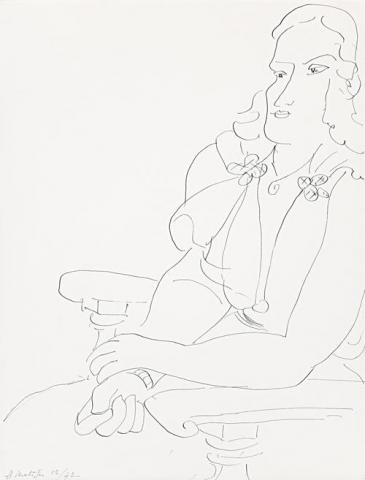JEUNE FEMME ASSISE (YOUNG WOMAN SEATED), 1942
Henri Matisse
ink on paper
51.0 x 41.0 cm
signed and dated lower left: Henri Matisse 12 / 1942
Accompanied by a certificate of authenticity from the Archives Matisse, dated 24 January 2005, confirming that this work is registered as no. H 132 in the Archives
Estate of the artist
Pierre Matisse Gallery, New York (label attached verso)
Acquired from the above in 1959, private collection, Connecticut, USA
Private collection, Melbourne
'...My drawing is the most direct and purest translation of my emotion. This is made possible by simplification of media. I have the feeling that my emotion expresses itself through the medium of plastic writing. As soon as my line - inspired, so to speak, with a life of its own - has moulded into the light of the empty sheet without destroying the tender whiteness of the paper, I stop. I can no longer add or change. The page it written, no correction is possible.'1
With its delicacy of touch, elegant line and mood of serene calm, Jeune Femme Assise, 1942, is a superb example of Matisse's enduring artistic aspiration to 'reconceive in simplicity' - to capture the essence of his subject through the simplest of technique. As the artist confided to Henry Clifford, the curator of his retrospective at the Philadelphia Museum of Art in 1948, he always sought to conceal his efforts in order to imbue his art with 'the lightness and joyousness of a springtime which never lets anyone suspect the labours it has cost.'2 Yet such an aesthetic also had it drawbacks; as Matisse lamented to Clifford, '...young artists, seeing in my work only the appearance of facility and of negligence in the drawing, will use this as an excuse for dispensing with certain efforts which I believe necessary.'3
From the late 1920s onward, Matisse regularly insisted that his ink drawings were the most successful and essential component of his artistic practice. While fundamental to his pursuits as a painter, it is important to note that most of his drawings do not represent compositions intended for paintings. That works such as the present should be considered achievements in their own right is reiterated by Matisse scholar Ernst Guse: 'There is nothing provisional about his drawings: they are complete, finished works resulting from an extended process of identification. The line which encircles the objects has supplied a final conclusive definition.'4
Given the striking physiological resemblance of the sitter in Jeune Femme Assise to the female portrayed in the painting Monique which Matisse was working on at the time, it would seem likely that the present drawing is a portrait of the student nurse, Monique Bourgeois, who first met the aging artist in 1942, following his advertisement for a 'young and pretty night nurse' to assist him in his recovery from cancer. Better known as Sister Jacques-Marie after her entry into the Dominican order in 1943, she was the plainspoken nun whose warm, uncomplicated friendship with Matisse famously culminated in his beautiful decorations for the Rosary Chapel, Vence - today widely acclaimed his greatest masterpiece. Although media speculation at the unveiling of the commission implied their affection was more than purely platonic, Sister Jacques-Marie remained steadfast in her denial of such innuendo, noting she '...was more like a granddaughter or a muse.'5 Indeed, when Matisse asked her to pose for him upon the conclusion of her assignment, she was surprised for, in her opinion, she had'never been considered a beauty.' Admiring 'the splendid mass of her dark hair and the way her neck rose from her shoulders like a white tower', clearly Matisse thought differently, immortalising her in numerous drawings and paintings, including Monique in a Grey Robe; The Idol; Green Dress and Oranges; and Tabac Royal.
1. Matisse cited in Lieberman, W. et al., Henri Matisse, University of California Press, Berkeley, 1966, p. 25
2. Matisse cited in Flam, J.D., Matisse on Art, Phaidon, London, 1973, pp. 120-121
3. ibid.
4. Guse, E.G., Matisse, Drawings and Sculpture, Munich, 1991, p. 10
5. Sister Jacques-Marie cited in Berger, J., 'Sister Jacques-Marie, Influence for Matisse's Rosary Chapel, Dies', New York Times, 29 September 2005.
VERONICA ANGELATOS
